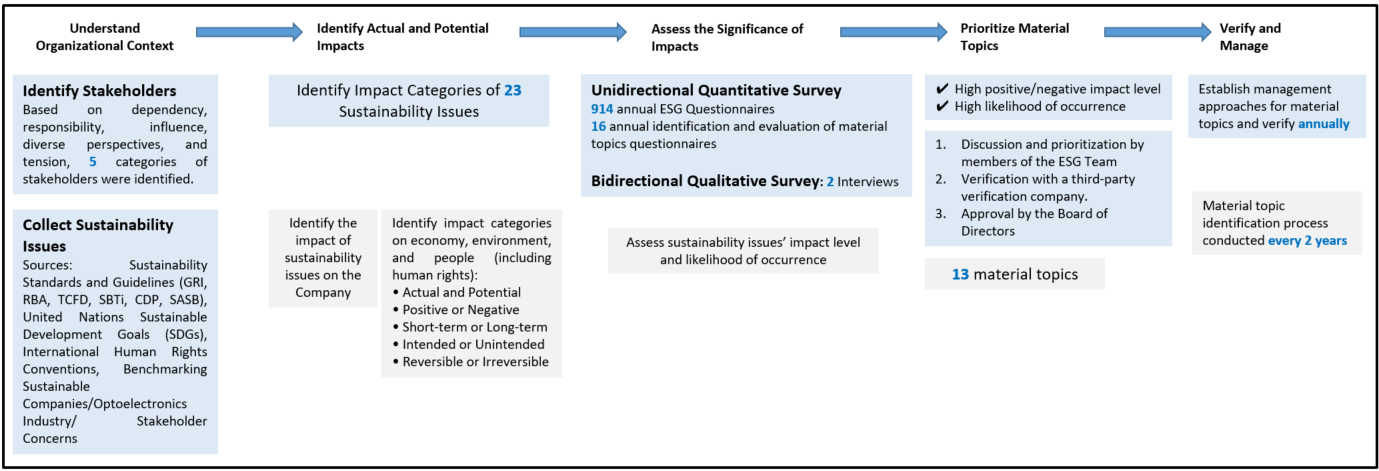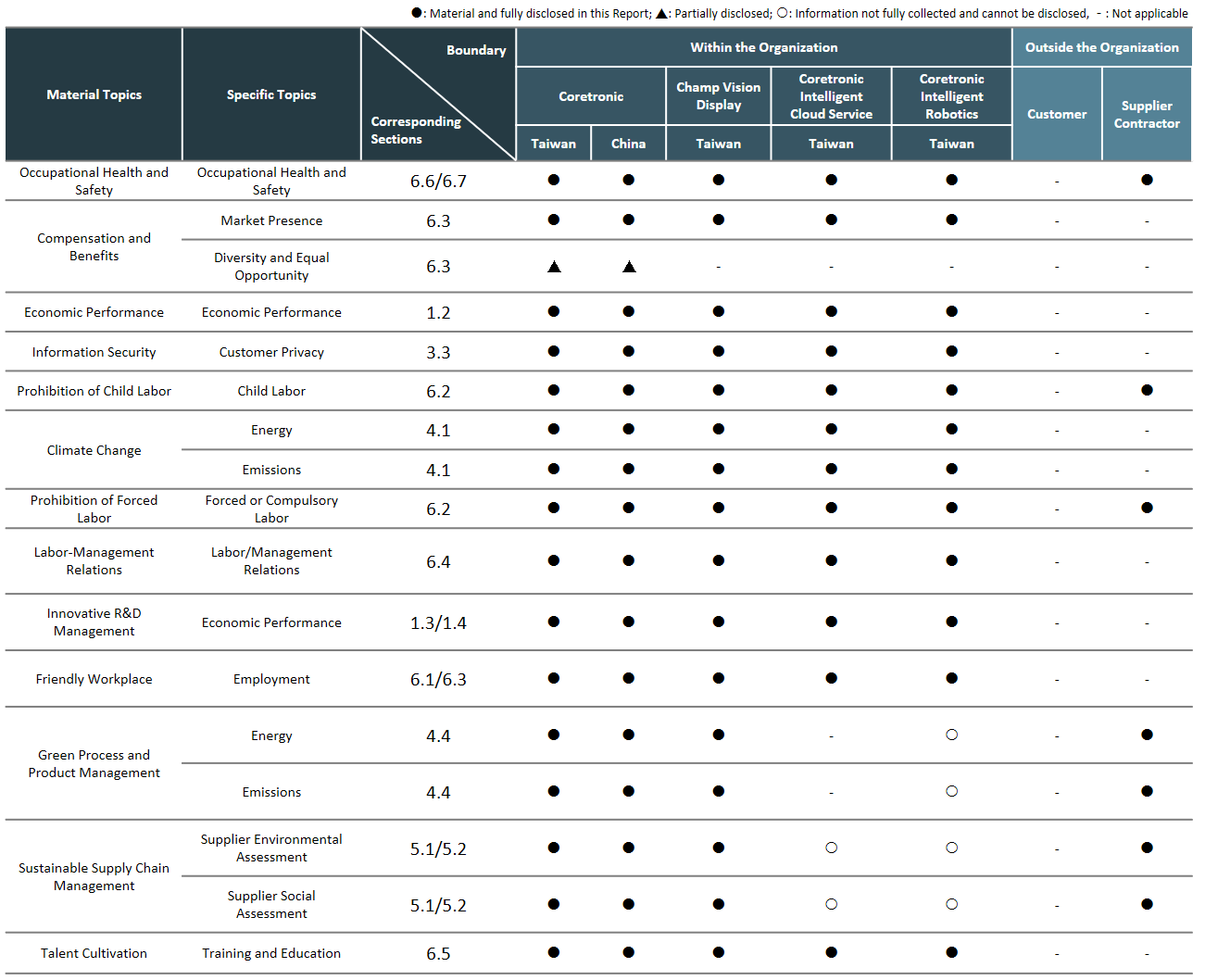Issue Date:August 08, 2025
Material Topics
According to the GRI Universal Standards 2021 under the Global Reporting Initiative (GRI) Standards system, specifically GRI 3: Material Topics 2021, companies are required to conduct due diligence and disclose in their Sustainability Reports the processes for identifying, preventing, mitigating, and explaining how they address their actual and potential negative impacts on the economy, environment, and people (including human rights). This process must be documented to ensure consensus and approval within the Company’s sustainability-related organizations and serve as the standard procedure for future material topic identification.
In 2024, Coretronic followed the above GRI Standards to establish its Material Topic Identification Process. The principle of “impact level” was used to assess whether a topic qualifies as material. The process involved evaluating the positive and negative impacts, the scope of impact, and the likelihood of occurrence for each topic. Subsequently, discussions and prioritization were conducted by the ESG Team members, followed by verification by an external assurance body. The final list of “Material Topics for the 2024 Sustainability Report”, including the Material Topic Identification Process and 13 identified material topics, was approved by the Board of Directors on February 17, 2025.

Material Topic Identification Process
Understanding Organizational Context
- Stakeholder Identification and Engagement
Questionnaires were distributed to 222 senior executives of the Company and asked them to identify the 5 most influential stakeholders based on the AA1000 SES (2015) assessment criteria of “Dependency”, “Responsibility”, “Influence”, “Diverse Perspectives”, and “Tension”. They were then asked to rank the importance of each stakeholder from 1-9 (1 being the least important and 9 being the most important), and finally determine the importance ranking of stakeholders based on the average score.
The Company actively assesses stakeholders’ needs and expectations of Coretronic through Annual Material Topics Questionnaires, Chinese/English Sustainability Report, Chinese/English Annual Report, Chinese/English TCFD Report, ESG Quarterly E-Newsletter、Official Website、Facebook fan page, YouTube channel, Wikipedia, ESG mailbox, and the following diverse communication channels, which serves as important references for formulating the Company’s sustainability policies and related plans. - Collect Sustainability Issues
Referring to standards and guidelines such as the GRI Standards, Responsible Business Alliance Code of Conduct (RBA), Task Force on Climate-related Financial Disclosures (TCFD), Science Based Targets initiative (SBTi), Carbon Disclosure Project (CDP), Sustainability Accounting Standards Board (SASB) Sustainability Indicators, United Nations Sustainable Development Goals (SDGs), and International Human Rights Conventions, as well as the key sustainability topics of benchmark companies in the sustainability field, the optoelectronics industry, the electronics manufacturing industry, and stakeholder concerns, Coretronic compiled a list of annual sustainability issues to serve as the core framework for the development of questionnaires and interviews.
Identify Actual and Potential Impacts
Following the definition of “impact” under the GRI Universal Standards (2021), Coretronic identified the actual and potential impacts of its 23 sustainability issues on the economy, environment, and people (including human rights). This assessment covers impacts that may be actual or potential, positive or negative, short-term or long-term, intentional or unintentional, and reversible or irreversible.Assess the Significance of Impacts
Using the Company’s daily operations as the reference background, Coretronic evaluated the 23 sustainability issues by scoring the positive impact level (benefit), negative impact level (severity), and the likelihood of occurrence for both positive and negative impacts.- Unidirectional Quantitative Survey: Collected responses from 222 senior executives and 692 stakeholders through the “Annual ESG Questionnaire”, and from 16 ESG Committee members through the “Annual Identification and Evaluation of Material Topics Questionnaire”.
- Bidirectional Qualitative Survey: Conducted 2 rounds of interviews with the ESG Team under the ESG Committee.
Screening of Material Topics
-
Based on the results of the “Annual ESG Questionnaire” and the “Annual Identification and Evaluation of Material Topics Questionnaire”, Coretronic screened each sustainability issue by evaluating its positive and negative “impact level” and “likelihood of occurrence”.
- Sustainability issues with both a high positive impact level and a high likelihood of occurrence (both scores ≥ 8.5) were selected as “Positive Impact Topics”, while issues with both a high negative impact level and a high likelihood of occurrence (both scores ≥ 8.5) were selected as “Negative Impact Topics”. The selected positive and negative impact topics together constituted the “Material Topics”.
Prioritization of Material Topics
-
The weighted total scores for negative impact level (with an additional weighting of 0.1 for people-related issues) and the scores for positive impact level were each ranked from highest to lowest.
-
Material topics were first prioritized based on the weighted total scores for negative impact level.
-
Positive impact topics were then added to the ranking, with priority still given to topics with higher negative impact weighted scores; in the case of a tie, the topic with the higher positive impact score was prioritized.
Approval of Material Topics
-
Interviews were conducted with members of the ESG Team under the ESG Committee to discuss the Company's previous year's actual operational performance and the implementation of management strategies, after which the annual material topics were determined.
-
The material topics were verified in collaboration with a third-party verification company.
-
The material topics were submitted to the Board of Directors for approval and were formally approved on February 17, 2025, as the “Material Topics for the 2024 Sustainability Report”.
-
Relevant targets and strategies were established for each material topic.
Identification Results
Economic Aspect
- Economic Performance
- Innovative R&D Management
- Sustainable Supply Chain Management
Social/ Human Rights Aspect
- Occupational Health and Safety
- Compensation and Benefits
- Information Security
- Prohibition of Child Labor
- Prohibition of Forced Labor
- Labor-Management Relations
- Friendly Workplace
- Talent Cultivation
Environmental Aspect
- Climate Change
- Green Process and Product Management
Boundary and Scope
2024 Sustainability Report is based on the organizational structure of affiliated companies and the internal supply chain (as shown in the diagram below) from the 2024 Consolidated Business Report of Affiliated Companies, serving as the foundation for the identification of material topics. It further identifies material topics for companies with substantial production, in which the company holds more than 50% ownership, have a significant economic, environmental and social impact on the Company, have upstream or downstream relationships with the Company, and where the Company can control the operations of non-controlling and venture capital investees.

- The scope of 2024 Sustainability Report includes: Coretronic’s Taiwan Plants (Headquarters, Chunan Plant, Tainan Plant 1, Tainan Plant 2), Coretronic’s China plants (Kunshan plants: Coretronic Projection (Kunshan), Coretronic Optics (Kunshan); Wujiang plants: Coretronic Optotech (Suzhou), Coretronic Optics (Suzhuo)), and subsidiaries in Taiwan (Champ Vision Display, Coretronic Intelligent Cloud Service, Coretronic Intelligent Robotics).
- Furthermore, for identifying material topics outside the organization, Coretronic selected stakeholders with high importance and high relevance to the Company's daily operations from 5 stakeholder groups, including customers, and suppliers/contractors, to conduct the identification.

